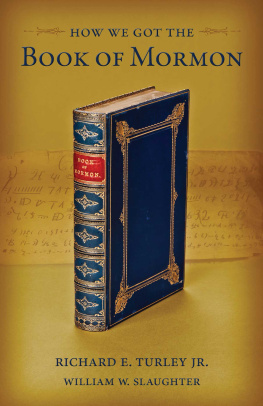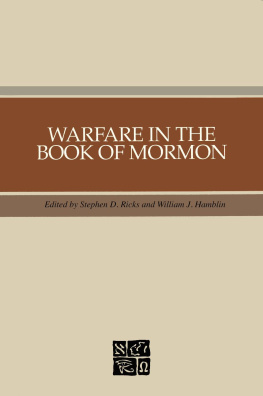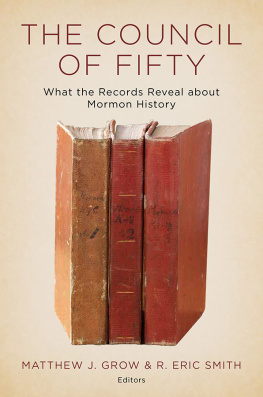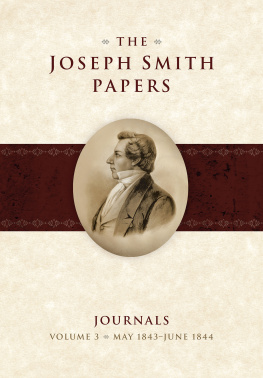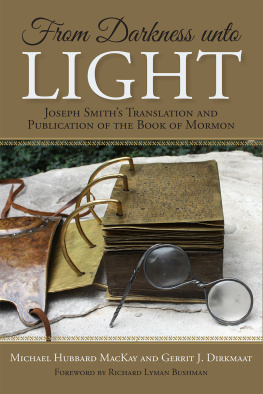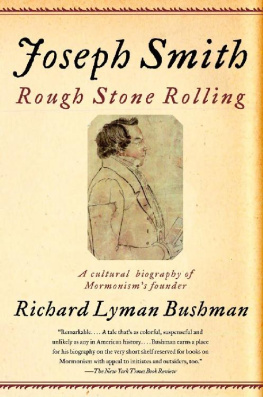William L. Davis - Visions in a Seer Stone: Joseph Smith and the Making of the Book of Mormon
Here you can read online William L. Davis - Visions in a Seer Stone: Joseph Smith and the Making of the Book of Mormon full text of the book (entire story) in english for free. Download pdf and epub, get meaning, cover and reviews about this ebook. publisher: The University of North Carolina Press, genre: Religion. Description of the work, (preface) as well as reviews are available. Best literature library LitArk.com created for fans of good reading and offers a wide selection of genres:
Romance novel
Science fiction
Adventure
Detective
Science
History
Home and family
Prose
Art
Politics
Computer
Non-fiction
Religion
Business
Children
Humor
Choose a favorite category and find really read worthwhile books. Enjoy immersion in the world of imagination, feel the emotions of the characters or learn something new for yourself, make an fascinating discovery.

- Book:Visions in a Seer Stone: Joseph Smith and the Making of the Book of Mormon
- Author:
- Publisher:The University of North Carolina Press
- Genre:
- Rating:5 / 5
- Favourites:Add to favourites
- Your mark:
- 100
- 1
- 2
- 3
- 4
- 5
Visions in a Seer Stone: Joseph Smith and the Making of the Book of Mormon: summary, description and annotation
We offer to read an annotation, description, summary or preface (depends on what the author of the book "Visions in a Seer Stone: Joseph Smith and the Making of the Book of Mormon" wrote himself). If you haven't found the necessary information about the book — write in the comments, we will try to find it.
William L. Davis: author's other books
Who wrote Visions in a Seer Stone: Joseph Smith and the Making of the Book of Mormon? Find out the surname, the name of the author of the book and a list of all author's works by series.
Visions in a Seer Stone: Joseph Smith and the Making of the Book of Mormon — read online for free the complete book (whole text) full work
Below is the text of the book, divided by pages. System saving the place of the last page read, allows you to conveniently read the book "Visions in a Seer Stone: Joseph Smith and the Making of the Book of Mormon" online for free, without having to search again every time where you left off. Put a bookmark, and you can go to the page where you finished reading at any time.
Font size:
Interval:
Bookmark:
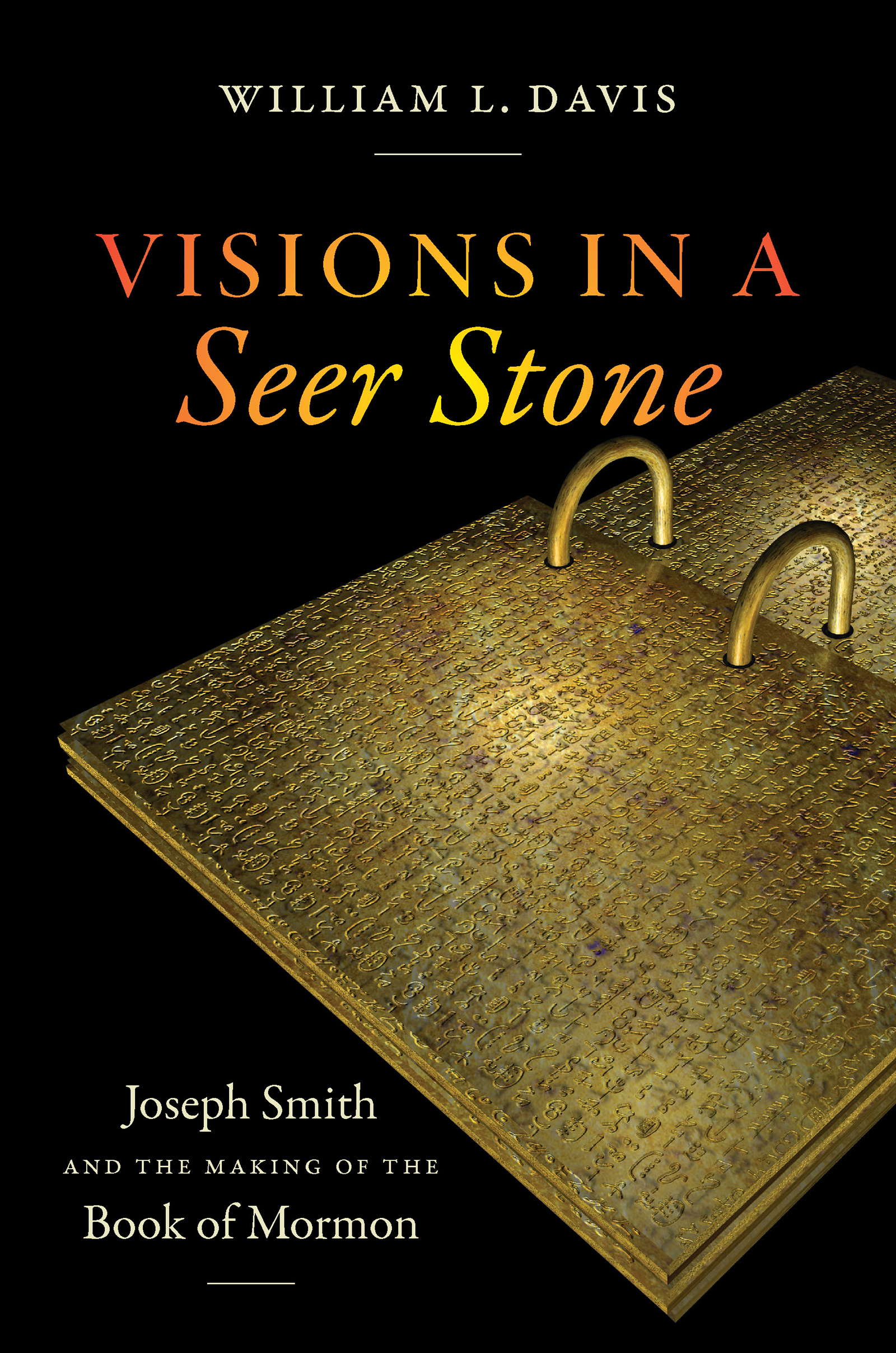
Visions in a Seer Stone
WILLIAM L. DAVIS
Visions in a Seer Stone
Joseph Smith and the Making of the Book of Mormon
The University of North Carolina Press Chapel Hill
2020 William L. Davis
All rights reserved
Set in Arno Pro by Westchester Publishing Services
Manufactured in the United States of America
The University of North Carolina Press has been a member of the Green Press Initiative since 2003.
Library of Congress Cataloging-in-Publication Data
Names: Davis, William L., 1968 author.
Title: Visions in a seer stone : Joseph Smith and the making of the Book of Mormon / William L. Davis.
Other titles: Joseph Smith and the making of the Book of Mormon
Description: Chapel Hill : The University of North Carolina Press, 2020. | Includes bibliographical references and index.
Identifiers: LCCN 2019037839 | ISBN 9781469655659 (cloth) | ISBN 9781469655666 (paperback) | ISBN 9781469655673 (ebook)
Subjects: LCSH: Book of Mormon. | Smith, Joseph, Jr., 18051844.
Classification: LCC BX8627 .D39 2020 | DDC 289.3092dc23
LC record available at https://lccn.loc.gov/2019037839
Cover illustration of engraved plates by author.
My interest in the Book of Mormon began in childhood, though not initially from any personal desire or intense curiosity. Whenever I asked my mother to tell me bedtime stories, she almost never regaled me with magical fairytales. Much to my chagrin, she rather told me countless stories about our familys Mormon pioneer ancestors, interspersed with tales of ancient Christian prophets and warriors from the pages of the Book of Mormon. Nevertheless, though hobbits, elves, and wizards were more congruent with my youthful tastes, I began to appreciate the stories and messages in the Book of Mormon. Joseph Smith, the prophet of the Latter Day Saint movement, claimed that the ancient American epic was the the most correct of any book on earth. Such a confident declaration influenced me to embrace the work literally and wholeheartedly, to study its stories in painstaking detail, trusting that every passage, every verse, every word had the potential to unlock the mysteries of God. I examined the language, the turns of phrases, the rhythms, the stories, and the messages. I created my own timelines for narratives, traced out the sermon topics of ancient prophets, sketched maps of the cities and battles, built genealogy charts, and memorized select verses. Because my core beliefs ultimately anchored on the Book of Mormon, no other text was more important to me, and I dedicated my time and resources to understanding it to the best of my ability.
By the time I was in my mid-twenties, and though I continued my study of the Book of Mormon, I began to withdraw from active participation in the Mormon faith. A variety of reasons contributed to my decision, ranging from my own evolving spirituality to concerns about the leadership of the LDS Church (officially the Church of Jesus Christ of Latter-day Saints, commonly known simply as the Mormons) and the direction in which the institution was heading. Over the next several years, I moved from being an active and devout believer to a nonparticipant. Today, having now passed the half-century mark of age, I have spent more of my life on the far perimeter of the faith than within it. Even so, throughout all these developments, I have continued to read and examine the Book of Mormon. Such dedication ultimately derives from, and continues to reflect, a personal interest in the origins of my identity and how the Book of Mormon played a fundamental role during my formative years.
For me and many other people growing up in the faith, Mormonism represented much more than a religious organization. The church stood at the center of life, shaping ones sense of identity (for this life and the next), ones relationship to God and to other people, and ones values and beliefs. I saw the world through a very specific Mormon cultural lens, a lens so concentrating and all-encompassing that I was not aware of its ubiquitous presence framing every aspect of life. Neither was I aware that the paradigm was a cultural construct, comprised of a set of unquestioned premises that shaped how I viewed and interpreted the world. All facets of life ultimately revolved around the LDS faith and the culture it created, and the Book of Mormon sat at the center of that universe, anchoring and validating every aspect of life. For me personally, understanding the text therefore became a central preoccupation. Understanding how Joseph Smith produced the work directly correlated to understanding the construction of my own identity and how the specific spiritual and cultural inheritances of my childhood shaped my life and worldview.
I share this personal background for a reason. As Paul C. Gutjahr observes in The Book of Mormon: A Biography, the history of scholarship on the Book of Mormon has largely fallen into two camps: Mormon educational and apologetic texts and Evangelical works attacking the books veracity. Thus, almost by default, scholars of the Book of Mormon, at least in the past, have often been shuffled into one of two opposing categories: defenders of the faith or critics of the church. Given such circumstances, my past participation in the LDS Church will most certainly influence the ways in which some readers perceive this work and respond to this study. Nevertheless, this project is not a devotional effort; it is not invested in either proving or disproving religious claims. I do not aspire to participate in the former (and, unfortunately, sometimes still current) parochial and polemical battles between the defenders and critics of Mormon beliefs.
For my part, I am positioning this project within the rising academic field of Mormon studies, with a specific emphasis on evidentiary support for claims and a conscious avoidance of church doctrines and official beliefs. In recent years, many academic scholarsscholars who have no desire either to support or attack Mormonisms religious claimshave taken an interest in the Book of Mormon as a legitimate object of historical study, particularly when considering how the text informs (and is informed by) our understanding of religious history and various aspects of early American culture. As Laurie F. Maffly-Kipp argues, For any reader wanting to learn more about the history of American religion, the Book of Mormon is an indispensable document.I see this work as part of that academic project. Regardless of what one believes about its historical or sacral authenticity, the Book of Mormon reveals important information about nineteenth-century American culture, particularly regarding oral culture and the formation of American literature among the non-elite classes of democratic-minded citizens, whose voices often emerged through the spoken word along religious avenues and byways.
Readers hoping for a study that debunks Joseph Smith and attacks the Book of Mormon will be disappointed with this work. This is not to say, however, that I will not be challenging some of the unofficial, nondoctrinal traditions and theories surrounding the text. In an effort to distance Smith from the authorship of the Book of Mormon, a segment of Mormon scholars has attempted to downplay or even erase nineteenth-century influences on the work. While such efforts might be understandable, at least from a religious point of view that seeks to limit inquiries into the nature and origin of ones sacred text, I believe such efforts are ultimately misguided and lead to faulty perceptions and self-imposed blind spots about the past. Some argue, for example, that Smith was too illiterate, unschooled, and ignorant to have composed the Book of Mormon. While Smiths formal educational opportunities were, in fact, limited and sporadic, a close examination of the evidence nevertheless reveals that such claims derive from anecdotal accounts and problematic representations, undermining the stability of such assertions as accurate depictions of his supposed lack of ability. Objectivity and impartial evaluations never appeared to be the goal in such accounts. The context of such claims inevitably reflects the desires and perceptions of the speakers describing Smith, rather than an attempt to provide objective information about his actual skills, knowledge, or capabilities.
Font size:
Interval:
Bookmark:
Similar books «Visions in a Seer Stone: Joseph Smith and the Making of the Book of Mormon»
Look at similar books to Visions in a Seer Stone: Joseph Smith and the Making of the Book of Mormon. We have selected literature similar in name and meaning in the hope of providing readers with more options to find new, interesting, not yet read works.
Discussion, reviews of the book Visions in a Seer Stone: Joseph Smith and the Making of the Book of Mormon and just readers' own opinions. Leave your comments, write what you think about the work, its meaning or the main characters. Specify what exactly you liked and what you didn't like, and why you think so.

